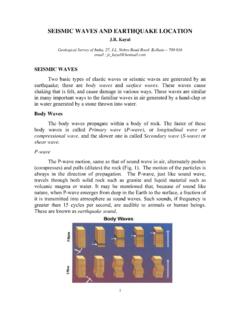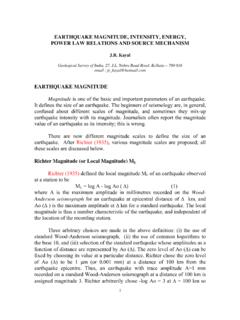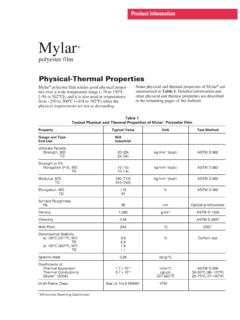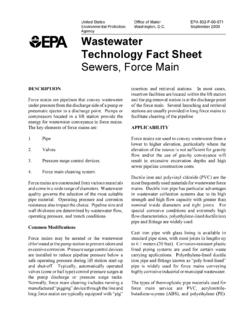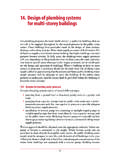Transcription of Overview of the 2010 Haiti Earthquake - USGS
1 Overview of the 2010 Haiti Earthquake Reginald DesRoches,a) , Mary Comerio,b) , Marc Eberhard,c) , Walter Mooney,d) , and Glenn J. Rix,a) The 12 January 2010 Mw Earthquake in the Republic of Haiti caused an estimated 300,000 deaths, displaced more than a million people, and damaged nearly half of all structures in the epicentral area. We provide an Overview of the historical, seismological, geotechnical, structural, lifeline-related, and socioeco- nomic factors that contributed to the catastrophe. We also describe some of the many challenges that must be overcome to enable Haiti to recover from this event. Detailed analyses of these issues are presented in other papers in this volume. [DOI: ]. INTRODUCTION. On 12 January 2010 , at 4:53 local time, a magnitude Earthquake struck the Republic of Haiti , with an epicenter located approximately 25 km south and west of the cap- ital city of Port-au-Prince.
2 Near the epicenter of the Earthquake , in the city of Le oga ne, it is estimated that 80% 90% of the buildings were critically damaged or destroyed. The metro- politan Port-au-Prince region, which includes the cities of Carrefour, Pe tion-Ville, Delmas, Tabarre, Cite Soleil, and Kenscoff, was also severely affected. According to the Govern- ment of Haiti , the Earthquake left more than 316,000 dead or missing, 300,0001 injured, and over million homeless (GOH 2010 ). According to the Inter-American Development Bank (IDB) the Earthquake was the most destructive event any country has experienced in modern times when measured in terms of the number of people killed as a percentage of the country's population (Cavallo et al. 2010 ). The Republic of Haiti occupies the western third (27,750 km2) of the island of Hispa- niola, located in the northeast Caribbean between Puerto Rico to the east and Jamaica and Cuba to the west (Figure 1), and had a population of approximately million prior to the Earthquake .
3 The metropolitan area surrounding its largest city, Port-au-Prince, has an esti- mated population of 3 million. Haiti has been impacted by other natural disasters in recent years. In 2008, more than 800 people were killed by a series of four hurricanes and tropical storms that struck Haiti during a two-month period. a). Georgia Institute of Technology, School of Civil and Environmental Engineering, 790 Atlantic Dr., Atlanta GA. 30332-0355. b). University of California Berkeley, Department of Architecture, 232 Wurster Hall, Berkeley, CA 74720-1800. c). University of Washington, Department of Civil and Environmental Engineering, 233 More Hall, Seattle, WA. 98195-2700. d). Earthquake Science Center, US Geological Survey, MS977, 345 Middle eld Rd., Menlo Park, CA 94025. 1. The number of casualties is a highly debated issue, with estimates ranging from 70,000 to 316,000.
4 At the time of this publication, the of cial number from the Government of Haiti is 316,000. S1. Earthquake Spectra, Volume 27, No. S1, pages S1 S21, October 2011; V. C 2011, Earthquake Engineering Research Institute S2 DESROCHES ET AL. Figure 1. Geographic and tectonic setting of the island of Hispaniola, of which Haiti occupies the western third. The 2010 Earthquake occurred on or near the Enriquillo-Plantain Garden fault zone and was preceded by earthquakes in southern Haiti in 1751 (two events, in October and November), 1770, and 1860. The location of the main shock of 12 January 2010 and aftershocks are shown in Figure 2. The damage to the infrastructure from the Earthquake in Haiti was staggering. More than 300,000 homes collapsed or were critically damaged. It is estimated that 60% of the nation's administrative and economic infrastructure was lost, and 80% of the schools and more than 50% of the hospitals were destroyed or damaged (GOH 2010 ).
5 More than 180. government buildings and 13 out of 15 key government of ces collapsed, including the presidential palace and parliament. The partial destruction of the main port of Port-au-Prince and blockage of roads from debris hampered the response and recovery for many months af- ter the Earthquake . Even nine months after the Earthquake , the destruction continued to dis- rupt the lives of many Haitians. The Interim Haitian Reconstruction Commission estimated that as of 12 October, million people were still displaced either in one of the more than 1,300 camps and other settlements registered by the International Organization for Migration (IOM) or in temporary housing situations in both the quake-affected zone and in non-affected regions (IHRC 2010 ). Overall losses and damages from the Earthquake are estimated to be between US$7 bil- lion and US$14 billion (approximately 100% 200% of Haiti 's gross domestic product), making this the most costly Earthquake event in terms of the percentage of a country's gross domestic product (Cavallo et al.)
6 2010 ). PRE- Earthquake Haiti : SETTING THE CONTEXT. It is dif cult to quantify the impact of pre- Earthquake conditions on the devastation resulting from the Earthquake in Haiti . However, there is no doubt that the dire socioeco- nomic conditions that existed prior to the Earthquake were a major contributor to the Overview OF THE 2010 Haiti Earthquake S3. resulting damage. Following a slave rebellion in 1804, Haiti became the rst free black nation in the world. It was subsequently forced to pay France a massive indemnity for prop- erties lost in that rebellion, and was ostracized socially and economically by countries all around the world. Haiti subsequently became entrapped in a cycle of poverty and misgov- ernment from which it has never emerged (Heinl 1996). Haiti is the poorest country in the Western Hemisphere, ranking 145 out of 169 on the UN Human Development Index (UNDP 2010 ).
7 Less than 10% of the population has access to potable tap water and less than one-third has access to electricity, even intermittently (UNSD 2010 ), which are the lowest respective percentages in the Western Hemisphere. More than half of Haiti 's population lives on less than US$1 per day, and more than three- quarters live on less than US$2 per day. Haiti has the highest rate of mortality among infants, children under 5, and during maternity of any country in the Western Hemisphere (UNSD 2010 ). Haiti 's exports are small: 10% of the gross domestic product. Haiti 's poor economic performance is, in part, the result of the decline of its agricultural sector, which in turn is due in large part to the degradation of the environment. Haiti ranks 155 out of 163. countries when it comes to general environmental degradation. For years, Haitians have cut down trees to use as cooking fuel, resulting in less than 3% of Haiti being covered by forest, a stark contrast to the lush forests of its neighbor, the Dominican Republic.
8 The environ- mental degradation only increases Haiti 's vulnerability to natural hazards. In addition to its poor socioeconomic standing, Haiti 's limited recent history of large earthquakes (Figure 1) left it unprepared for the 12 January 2010 , Earthquake . Haiti had few seismologists and no seismic network in the country. It only had one seismic hazard map, which was outdated and lacked suf cient detail to be useful. The best geological map dated to 1987 (Lambert et al. 1987). The building code was outdated, rarely used, and not enforced (CUBiC 1985). There was no Earthquake preparedness program and no contin- gency plan for earthquakes. The typical university curriculum did not include seismic design, seismology, or the geosciences. SEISMOLOGICAL ASPECTS. GEOLOGY AND TECTONICS. The geologic evolution of Hispaniola can be traced to the Mesozoic breakup of Pangea and the creation of the Atlantic Ocean.
9 This process resulted in the formation of the Carib- bean microplate, with subduction zones forming around the margins (Garcia-Casco et al. 2008). The geology of Hispaniola, including Haiti , consists of igneous rocks formed within a volcanic island arc, as well as abundant marine sedimentary rocks that have accreted at the oceanic subduction margin (Woodring et al. 1924, Maurrasse 1982). The 12 January 2010 Earthquake occurred on or near the Enriquillo-Plantain Garden Fault, a prominent strike-slip fault that is clearly evident in high-resolution relief maps of the Southern Peninsula of Haiti . Field studies con rmed that the mapped Enriquillo-Plantain Garden Fault in the epicentral region separates basaltic rocks south of the fault from marine sedimentary rocks (chalk, sandstone, and limestone) to the north. Thus, the fault can be eas- ily discerned by its morphology and geology.
10 However, detailed eld and geophysical stud- ies indicate that the fault rupture was a complex event that involved slip on more than just S4 DESROCHES ET AL. the Enriquillo-Plantain Garden Fault (Nettles and Hjo rleifsdo ttir 2010 , Prentice et al. 2010 , Calais et al. 2010 , Hayes et al. 2010 ). SEISMICITY. For several decades prior to the 12 January 2010 Earthquake , seismic activity within the island of Hispaniola had been heavily concentrated in the eastern two-thirds of the island in the Dominican Republic, and Haiti had been relatively seismically quiescent. Indeed, since the establishment of a modern global seismic network in 1964, the Port-au-Prince region of southern Haiti has experienced only one Earthquake of magnitude greater than , with sev- eral additional events occurring 100 km to the west. However, studies of historical seismic- ity have established that large (magnitude or greater) earthquakes have struck the Port- au-Prince region in the historic past.

